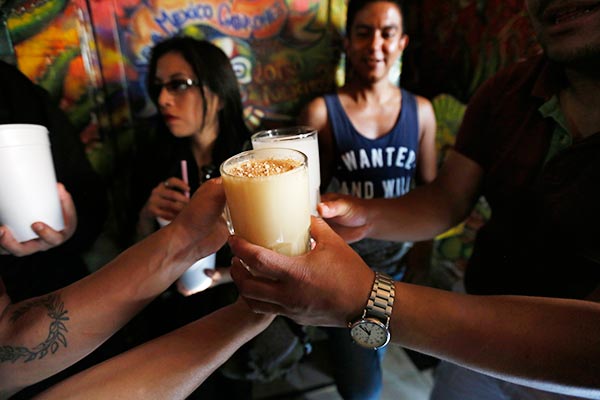 |
|
Glasses filled with pulque are delivered to a customer. [Photo/Agencies] |
Mexicans have been brewing pulque from the juice of cactus-like maguey plants for centuries, but the viscous, beer-like beverage fell out of favor starting in the 1970s as pulque got a bad reputation as a peasant's drink. The number of producers, consumers and bars known as "pulquerias" dwindled.
But now, the nutrient-rich drink is making a comeback among a new generation of Mexicans.
The Aztecs of Mexico's central highlands revered pulque, pronounced POOL-kay, reserving it for the highest social classes and the most august occasions.
Today, pulque is available in numerous flavors and strengths and you are as likely to see a tattooed millennial couple sipping a liter container of strawberry-flavored pulque outside a hipster bar as the farmers in cowboy hats who make and drink it in the countryside.
But don't expect it to appear on the shelves of the local liquor store.
History of pulque
For decades, attempts have failed to can or bottle the milky white liquid that continues to ferment quickly after being produced.
Pulque long had a reputation as the drink of poor farmers, and many assumed it was produced under unsanitary conditions-something its fans say is not true.
Antonio Gomez, a pulque producer in the community of Santiago Cuautlalpan in Tepotzotlan municipality just north of Mexico City, is among those who make the drink the old fashioned way, by hollowing out the pulpy heart of the region's maguey plant and using a sort of suction pipe to pull out the sugary liquid that collects in the hollow section. The liquid at that stage, known as aguamiel is barely alcoholic, if at all.
The liquid goes into plastic tanks to ferment, often for as little as 12 hours. With the addition of fruit juices, it comes in flavors such as guava, mango, coconut, strawberry and pineapple. At 6 percent alcohol content after fermentation, it's about as strong as the average beer.
Gomez said pulque was once served in some parts of Mexico in the morning, as well as for health reasons.
"The old people, they say that before, they didn't drink coffee; they had some pulque, tortillas and beans and that was their breakfast," he said.
"A lot of doctors are prescribing it as medicine," Gomez said. "A diabetic person, for example, should drink strong pulque."
Gomez said he worries about the old maguey fields that once sustained entire haciendas as they are torn up to make way for subdivisions and shopping malls.
"More than anything else, we have to continue planting magueys ... and take care of the fields, because other people, unfortunately, are coming out here to develop and build houses," he said.
|
|
|
|
|
|
|
|
